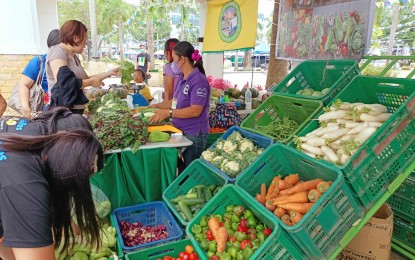
SLOWER INFLATION. Headline inflation falls to its lowest level in 22 months in December last year. The Philippine Statistics Authority said on Friday (Jan. 5, 2024) that inflation fell to 3.9 percent in December 2023. (PNA file photo)
MANILA – Headline inflation further eased to 3.9 percent in December last year, the lowest recorded since the 3 percent seen in February 2022.
In a briefing on Friday, National Statistician Dennis Mapa said the headline inflation last month was lower than the 4.1 percent in November 2023, and the 8.1 percent seen in December 2022.
It is also within the 3.6 to 4.4 percent forecast range of the Bangko Sentral ng Pilipinas (BSP) for the month.
Core inflation, which excludes volatile oil and food items, also decelerated to 4.4 percent from 4.7 percent in November.
Mapa said the downtrend was primarily due to the lower year-on-year growth in the index of housing, water, electricity, gas and other fuels at 1.5 percent in December 2023 from 2.5 percent the previous month.
This was followed by food and non-alcoholic beverages with 5.4 percent inflation in December from 5.7 percent in November 2023.
Food inflation alone eased to 5.5 percent from 5.8 percent the previous month.
Rice inflation, however, rose to 19.6 percent in December from 15.8 percent in November 2023.
For the full year 2023, headline inflation settled at 6 percent.
Following the trend at the national level, inflation in the National Capital Region (NCR) also decelerated to 3.5 percent in December from 4.2 percent in November.
For areas outside the NCR, inflation also eased to 4 percent from 4.1 percent the previous month.
Inflation for the bottom 30 percent households, however, slightly picked up to 5 percent from 4.9 percent due to the higher inflation for food and non-alcoholic beverages.
Risks to inflation outlook
In a statement, the BSP said the latest inflation outturn is consistent with its projections that inflation will likely moderate in the near term due to easing supply-side price pressures and negative base effects.
It noted, however, that the risks to the inflation outlook continue to lean significantly toward the upside.
"Key upside risks are associated with potential pressures from higher transport charges, increased electricity rates, higher oil prices, and higher food prices due to strong El Niño conditions," the BSP said.
It added that the impact of a relatively weak global recovery as well as government measures to mitigate the effects of El Niño could reduce the central forecast.
"Looking ahead, the Monetary Board deems it necessary to keep monetary policy settings sufficiently tight until a sustained downtrend in inflation becomes evident," the central bank said.
The BSP said it will continue to monitor inflation expectations and second-round effects and take appropriate action as needed to bring inflation back to the target in line with keeping with its price stability mandate.
Government measures
In separate statements, the National Economic and Development Authority (NEDA) and the Department of Finance said that despite the deceleration of inflation last month, the government will continue to monitor prices and inflation risks.
The NEDA also assured that the government will implement measures to protect the purchasing power of Filipino households.
NEDA Secretary Arsenio Balisacan also cited the importance of Executive Order 50, which extended the Most Favored Nation reduced tariff rates for key agricultural commodities like pork, corn and rice to ensure sufficient food supply for Filipinos, and prevent spikes in prices of these commodities.
“Amid an uptrend in international rice prices and the expected negative impact of the El Niño phenomenon, the Interagency Committee on Inflation and Market Outlook will closely monitor the situation and propose further temporary tariff adjustments if necessary," Balisacan said.
"We will also push for trade facilitation measures to reduce other non-tariff barriers. While our medium-term objective to boost agricultural productivity remains, it is important to augment domestic supply to ease inflationary pressures on consumers, particularly those in low-income households,” he added.
Balisacan said the El Niño phenomenon has added to the threat of higher inflation.
He cited the need to hasten the full implementation of the El Niño National Action Plan (NAP), which seeks to increase the resilience of communities against El Niño and guide government agencies in mitigating its immediate effects.
“We must remain vigilant in monitoring the prices of our commodities and continue to implement strategies to address short-term and long-term inflation-related challenges,” Balisacan said.
He said these include implementing timely deployment of trade policy tools along with sustained investments in irrigation, flood control, supply chain logistics and climate change adaptation.
Finance Secretary Benjamin Diokno, for his part, vowed that the government will soon release the guidelines of the toll rate hike exemption for trucks catering to agricultural goods.
Diokno said this will help mitigate the second-round effects of toll rate hikes on food inflation.
"The Department of Finance is working closely with the Toll Regulatory Board and tollway concessionaires toward the finalization of the said guidelines," he said.
Diokno said the expected completion of critical transmission projects in the first quarter of 2024, particularly the Mindanao-Visayas Interconnection project and the Cebu-Negros-Panay 230kV Backbone Stage 3, will also help moderate energy prices in the Visayas region. (PNA)
